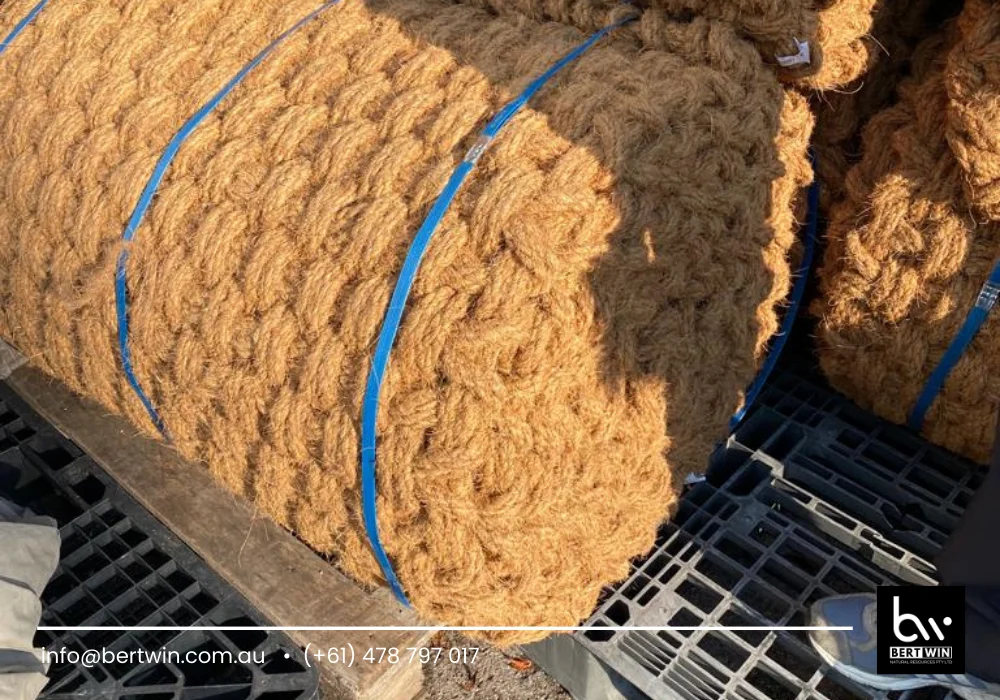
Did you know that nearly 1 billion acres of land worldwide are affected by soil erosion every year? Coir mat erosion control, made from biodegradable coconut matting with strong natural fibers, offers an effective solution to this critical issue. Crafted from coconut husks, coir mats provide natural protection against soil loss while promoting vegetation growth and enhancing soil stability. This eco-friendly option significantly reduces the impact of harsh weather conditions and supports sustainable land management practices. Discover how coir matting can be a game-changer for your landscaping and environmental projects.
Understanding Coir Mats
What Are Coir Mats
Coir mats are made from coconut husk fibers. These fibers are strong and durable. They help prevent soil erosion. Coir mats come in various sizes and can be rolled out easily on slopes or areas prone to erosion using coir matting rolls. These mats are essential for effective coir mat erosion control.
Natural Materials Used
Coir matting uses natural materials like coconut fibers and jute. Coconut fibers provide strength and durability. Jute adds extra stability. Both materials are biodegradable. This means they break down naturally over time, enriching the soil.
Benefits of Coir Mats
Coir mats offer several advantages for erosion control. They help retain moisture in the soil. This is important for plant growth. The mats also promote vegetation growth by allowing seeds to germinate. They reduce runoff during heavy rains, preventing soil loss.
Using coir mats can improve soil quality over time. They support biodiversity by creating a habitat for insects and small animals. Coir mats are cost-effective compared to other erosion control methods.
Coir Mat Erosion Control Basics
Causes of Soil Erosion
l erosion occurs due to several factors. Water and wind are the primary causes. Heavy rainfall can wash away soil, especially on steep slopes. Wind can blow loose soil particles away, particularly in dry areas. Human activities like deforestation and agriculture also increase erosion. These actions disturb the soil and remove protective vegetation.
Importance of Erosion Control
Erosion control is vital for maintaining healthy landscapes. It prevents loss of fertile soil, which is essential for agriculture. Controlling erosion protects water quality by reducing sediment in streams and rivers. It also minimizes damage to roads and buildings caused by runoff. Implementing effective erosion control solutions helps sustain ecosystems and supports biodiversity.
How Coir Mats Help
Coir mats serve as an effective erosion control product. Made from coconut fibers, they provide a natural barrier against erosion. These mats promote vegetation growth, which stabilizes soil. They absorb water, reducing runoff during heavy rains. Coir mats are also biodegradable, making them an environmentally friendly option.
Using coir mats in erosion management applications offers multiple benefits. They reduce soil loss while enhancing plant growth. By using these mats, landowners can protect their property while supporting sustainable practices.

Installation Process
Site Preparation Steps
Proper site preparation is crucial for effective erosion control. First, clear the area of debris and vegetation. This ensures that the coir mats can make direct contact with the soil. Next, level the ground to create a stable base. Uneven surfaces can lead to water pooling, which may cause erosion. Contractors often recommend testing the soil for drainage issues before installation. This helps in identifying any potential problems early on.
Laying the Coir Mats
After preparing the site, begin laying the coir mats. Start at the lowest point of the slope to allow water to flow naturally over them. Overlap each mat by at least six inches. This overlap prevents gaps where soil could wash away. Ensure that the mats lie flat against the ground. Any wrinkles or folds can trap water, leading to erosion underneath.
Securing the Mats Properly
Securing the mats is vital for their effectiveness. Use biodegradable stakes or pins to anchor them in place. Place stakes every three feet along the edges and in the center of each mat. This keeps them from shifting during heavy rains or winds. In some cases, contractors may suggest adding additional materials, like soil or gravel, on top for extra weight and stability. Proper installation of coir mats is essential for effective coir mat erosion control.
Maintenance and Longevity
Regular Inspection Tips
Inspect coir mats regularly. Look for signs of wear or damage. Check for loose edges or areas where the mat has lifted. Conduct inspections every few months, especially after heavy rainfall. This helps catch problems early. It also prevents larger issues later on.
Repairing Damaged Areas
Repair any damaged sections quickly. Use a coir patch to cover holes or tears. Secure the patch with natural adhesives and a sturdy coconut fiber erosion control mat to ensure it stays in place. If the mat is severely damaged, consider replacing that section entirely. Timely repairs maintain the effectiveness of erosion control.
Enhancing Durability
Enhance the durability of coir mats by applying a protective layer. Use biodegradable coatings that resist moisture and UV rays. These coatings can extend the life of the mat significantly. Avoid placing heavy equipment on the mats during maintenance work. This reduces unnecessary stress on the material.
Environmental Impact
Eco-Friendly Benefits
Coir mats are made from coconut husks. They offer a natural solution for erosion control. Unlike synthetic materials, coir is biodegradable. This means it breaks down over time, enriching the soil. The mats help stabilize slopes and prevent soil loss. They also absorb water, which reduces runoff. This feature protects nearby waterways from sedimentation.
Supporting Local Ecosystems
Using coir mats supports local ecosystems. They provide habitats for various species. Birds and insects find shelter in the dense fibers. The mats encourage plant growth by retaining moisture. Healthy plants can further prevent erosion by stabilizing the soil with their roots. This creates a thriving environment for wildlife.
Sustainable Practices
Implementing coir mats aligns with sustainable practices. They are renewable resources, as coconuts are harvested regularly. Using them reduces reliance on non-biodegradable materials. Coir mats require minimal maintenance, which lowers ongoing costs. Their effectiveness in controlling erosion, particularly through coir mat erosion control, makes them a long-term solution. Communities benefit from reduced soil degradation and improved land health.

Closing Thoughts
Coir mats are a smart choice for erosion control. They provide natural protection while promoting healthy soil and plant growth. Understanding the installation and maintenance processes can help you maximize their effectiveness. Plus, their environmental benefits are hard to ignore.
Investing in coir mats not only safeguards your landscape but also supports eco-friendly practices. If you’re looking to enhance your erosion control strategy, consider incorporating coir mats into your plan. Take action today to protect your land and promote sustainability. Your efforts can make a significant difference.
Frequently Asked Questions
What are coir mats made from?
Coir mats are made from coconut husk fibers. These natural fibers are durable, biodegradable, and highly effective for erosion control.
How do coir mats help with erosion control?
Coir mats prevent soil erosion by stabilizing the soil, promoting vegetation growth, and absorbing water. They provide a protective layer against wind and water runoff with a sturdy coconut fiber erosion control mat.
Can coir mats be used in all climates?
Yes, coir mats can be used in various climates. They are effective in both wet and dry conditions, making them versatile for different environments.
How long do coir mats last?
Coir mats typically last between 2 to 5 years, depending on environmental conditions and maintenance. Their natural composition allows them to degrade over time while still providing benefits.
Are coir mats environmentally friendly?
Absolutely! Coir mats are biodegradable and made from renewable resources. They support sustainable practices by enhancing soil health and reducing chemical runoff.
What is the installation process for coir mats?
The installation involves preparing the site, laying the mat over the area, securing it with stakes or pins, and ensuring proper soil contact. This simple process promotes effective erosion control.
Do coir mats require maintenance?
Minimal maintenance is needed for coir mats. Regular checks for stability and occasional watering help ensure they function effectively throughout their lifespan.
In conclusion, if you are eager to delve deeper into the details of coir products, feel free to explore our website at https://cocopeatcocofiberaustralia.com/. Additionally, for direct and instant connection with our team, you can reach us through the following WhatsApp link +61412773364. We look forward to providing you with the information and assistance you need.
